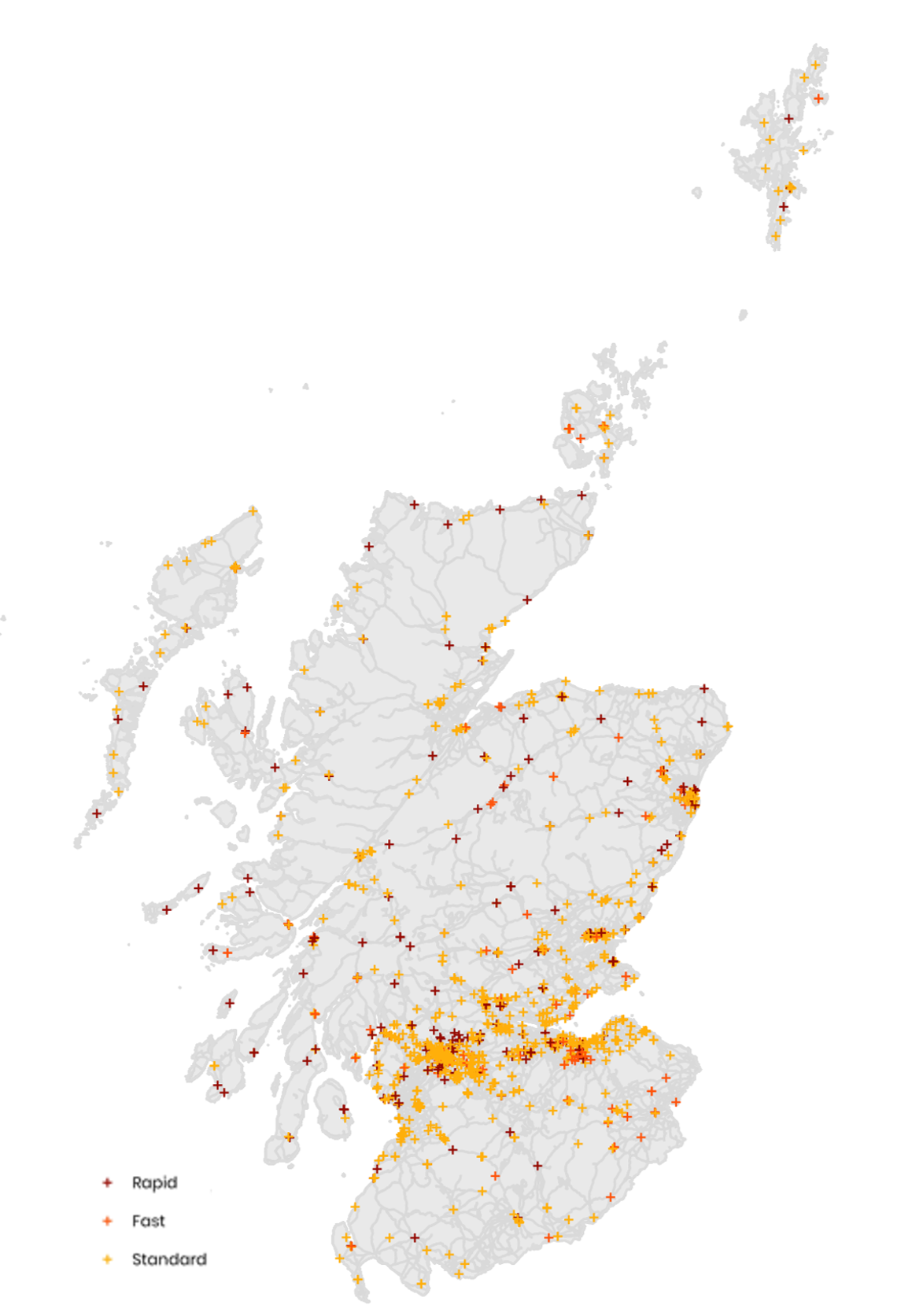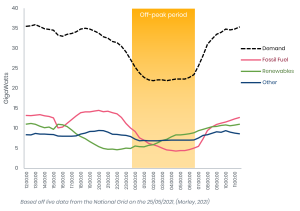3. Charging profiles
You need to consider several things when planning how to charge your fleet. This largely depends on how the vehicles in your fleet are used, including mileage, time spent in use, and where your vehicles are stored.
You need to consider several things when planning how to charge your fleet. This largely depends on how the vehicles in your fleet are used, including mileage, time spent in use, and where your vehicles are stored.
Sockets per vehicle
-
Installing chargers is expensive: make sure that the number of chargers you purchase meets your fleet requirements without significantly exceeding them.
The simplest solution is to use a 1:1 ratio of vehicles to charge point sockets. This is the optimal choice when transitioning from internal combustion engine (ICE) vehicles to battery electric vehicles (BEVs) to make recharging as simple as possible.
Staff buy-in is crucial to BEV adoption and a successful decarbonisation strategy, so it’s important to make charging as simple and convenient as possible. If every vehicle has its own socket, staff will not have to spend time searching for an available charger when a vehicle comes off shift.
The simplest solution usually involves installing basic chargers to charge vehicles at the highest possible rate. However, you would need to ensure that the sum of the power ratings of the charge points is below the static charging availability (see example 1 below).
However, this system can result in spikes in power demand. If everyone plugs in at the same time, all vehicles will try to draw the maximum allowable power.
If you need more sockets than your capacity allows, you will need to apply for a larger grid connection. This will be costly and may result in you incurring standing capacity charges. You may even require a new substation.
Individual charge points can be manually downrated to avoid exceeding the site capacity. This means they will supply electricity to vehicles below their rated capacity. However, this might prove impractical if vehicles sometimes need to charge more quickly (e.g., if shift patterns change).
An effective load management solution could allow you to install more sockets on the same grid connection. This will allow you to charge more vehicles at the same time at lower charging speeds (e.g. overnight).
If there are fewer vehicles charging, those plugged in can charge more quickly. This gives you more flexibility than downrating charge points.
You can also implement a dynamic load management solution if you need more charge points but want to avoid expensive grid upgrades. Dynamic load management allows you to dip into the power that is available elsewhere on the site (e.g., from buildings or offices) when it is not being consumed (see example 2). This system requires you to be able to actively monitor the building consumption in real time. It is the most expensive form of load management but offers the most flexibility.
Example 1:
Depot A has a capacity of 150kVA, assuming a 95% power factor the maximum consumption at the site would be 142.5kW.
A site office at Depot A currently uses 52.5kW during the day for lighting and heating and 12.5kW at night.
This leaves 90kW for static charging. With this capacity you could charge 12 vehicles on 7.4kW chargers.
Example 2:
The site office at Depot A uses 52.5kW during the day for lighting and heating and 12.5kW at night. This leaves 40kW in available capacity overnight.
With dynamic load management, this capacity could be used to charge five vehicles on 7.4kW chargers overnight, in addition to the 12 chargers using the static capacity.
Rota charging
-
As of December 2023, there are 4,495 charge points in Scotland, according to ZapMap. Scotland’s public electric vehicle (EV) charging network, ChargePlace Scotland (CPS), hosts a mix of different charger types, with standard, fast and rapid chargers available across the country. There are also many privately owned charge points available to the public.
Although the top range on a battery electric vehicle (BEV) is now around 345 miles (with an average range of around 200 miles), sometimes staff will need to drive further. If you have fleet vehicles regularly undertaking long journeys, you will likely need to use the public network to charge your vehicles at some point. Employees who keep a vehicle at home but cannot have a charge point installed will also need to use the public charging network.
The public network is large and still growing, so your drivers should never be too far from a charger. Before going to a charge point, drivers should confirm its location and current availability via a charge point app or website, such as ZapMap or ChargePlace Scotland.
Figure 3 shows the locations of charge points on the ChargePlace Scotland (CPS) network. It is not an exhaustive display of all the country’s public charging infrastructure: there are other charge point network operators in Scotland.
To access the CPS network, staff will need a CPS card or the CPS app. There is also the option to use CPS’s WebPay service, which allows drivers to pay for a charge without a CPS account. The CPS card can be linked to a company account, so employees don’t have to pay to use these public chargers themselves. These cards can be specific to a vehicle or staff member, so energy consumption can be monitored.
These days, most EVs can drive well over 100 miles on a single charge. This means some or all fleet vehicles don’t need to be charged every single day.
Using a rota system allows your staff to charge their vehicle at specific times and can reduce the number of charge points you require.
Keeping the rota system simple ensures your staff will stick to it. One approach is to have staff charge their vehicles at the same time(s) each week. You can also introduce other measures to avoid blocked charge points by vehicles that do not require a charge.
An effective system will need to be built for essential or unplanned charging, to avoid situations where a vehicle needs to charge, but a charge point is unavailable. Installing a small number of buffer chargers or even a rapid charger (depending on the depot size) will help mitigate this. Using the public charging network when on-site charge points are unavailable is also an option.
This system will require smart chargers so that charge point usage can be monitored and effectively managed. This will also allow you to stagger charging times to reduce demand from the grid and let you take advantage of time-of-use tariffs.

Charging vehicles on a rota could significantly cut the number of chargers required.
By analysing public sector fleets, we discovered that vehicles typically last an average of 30-50 miles daily (excluding weekends) if charged every second or third day.
Charging your vehicle overnight for 12 hours at 3.7kW could charge the battery with 44kWh of electricity, enough to drive 133 miles*.
You will need to establish the maximum daily mileage of each vehicle to understand which are suitable for rota charging and how frequently they would require charging. Installing telematics in your vehicles will give you more data on how your vehicles are driven.
* Based on a rough average of three miles used per kWh
Home charging
-
A home charging solution will likely be required for staff who take fleet vehicles home. This has its own challenges around charging these vehicles and reimbursing staff for the energy used.
You’ll first need to determine if fleet vehicles need to go home with staff. For those vehicles that do, you should ensure staff driving them have a home charge point installed if they have off-street parking at home. Those who can’t install a home charger will be heavily reliant on the public charging network.
The typical home charge point and installation cost is approximately £1,000. As part of its electric vehicle home charge scheme, the Office for Zero Emission Vehicles (OZEV) currently offers homeowners who live in flats and people in rental accommodation (flats and single-use properties) grant funding towards this cost. Scottish residents may be able to get further funding support for installing a home charge point from Energy Saving Trust – see the Energy Saving Trust website for details.
When reimbursing staff for personal electricity use, the advisory fuel rate (AFR) for battery electric vehicles (BEVs) is 10p per mile. Hybrid cars are treated as either petrol or diesel cars when calculating the mileage rates. You can check the fuel rates on gov.uk. Combining a telematics system with these fuel rates will allow you to accurately reimburse staff for business fuel use.
Other solutions include linking a third-party provider directly to the employee’s energy supplier. This means the employee can charge at home or on the public network without paying for the outstanding electricity bill. Instead, the provider sends the employer an invoice for all the energy consumed (both at the employee’s home and on the public network). This is currently being trialled by Mitie (Musk, 2020).
Another alternative is sharing neighbourhood chargers through platforms like Co Charger. This system allows people without off-street parking to share the charger of a neighbour with a driveway. It is a new idea, but it could be used alongside or instead of the public charging network.
We recommend you keep up to date with new charging solutions to find the best solution for you and your staff.

Public charging network
-
As of December 2023, there are 4,495 charge points in Scotland, according to ZapMap. Scotland’s public electric vehicle (EV) charging network, ChargePlace Scotland (CPS), hosts a mix of different charger types, with standard, fast and rapid chargers available across the country. There are also many privately owned charge points available to the public.
Although the top range on a battery electric vehicle (BEV) is now around 345 miles (with an average range of around 200 miles), sometimes staff will need to drive further. If you have fleet vehicles regularly undertaking long journeys, you will likely need to use the public network to charge of your vehicles at some point. Employees who keep a vehicle at home but cannot have a charge point installed will also need to use the public charging network.
The public network is large and still growing, so your drivers should never be too far from a charger. Before going to a charge point, drivers should confirm its location and current availability via a charge point app or website, such as ZapMap or ChargePlace Scotland.
Figure 39 shows the locations of charge points on the ChargePlace Scotland (CPS) network. It is not an exhaustive display of all the country’s public charging infrastructure: there are other charge point network operators in Scotland.
To access the CPS network, staff will need a CPS card or the CPS app. There is also the option to use CPS’s WebPay service, which allows drivers to pay for a charge without a CPS account. The CPS card can be linked to a company account, so employees don’t have to pay to use these public chargers themselves. These cards can be specific to a vehicle or staff member, so energy consumption can be monitored.
Image showcasing allocation of rapid, fast and standard chargers in Scotland.

When to charge
-
Ideally, your vehicles should be charged overnight to avoid large scale charging demand negatively impacting the grid.
During the working week (from 6am to 11pm) demand on the UK grid is at its maximum. Greenhouse gas (GHG) emission intensity (kgCO2e/kWh) from fossil fuel-based electricity generation may also be higher at these times to cope with demand.
You could reduce your fleet’s GHG emissions by around 10-15% by avoiding charging your vehicles during the peak demand period on the grid (6am to 11pm) (data from Morley, 2021). However, as the grid decarbonises (through the adoption of renewables), the amount of CO2e saved by charging off-peak will reduce.
In summer, you can use on-site solar PV generation in the late afternoon and early evening to charge vehicles when the domestic side load is falling. This means the electricity demand from buildings onsite is decreasing by people switching off things like computers and lighting at the end of the 9am-5pm working day. Using your own onsite solar PV, rather than using electricity from the grid, will save both money and reduce GHG emissions.
